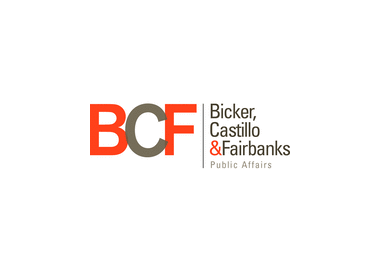








2nd Annual Journalism Awards Recipients
Congratulations to the winners of the 2nd Annual Journalism Awards Contest for politics and policy reporting in California. Journalists and industry members alike submitted their work from 2021 but only 17 contestants were chosen as award recipients and honored at our Journalism Awards Reception on April 20, 2022.
This award honors the California journalist whose work has had a substantial impact on the state. The Sacramento Press Club board will accept and vote on nominations from independent news organizations or a colleague of the journalist. A nomination letter must detail, with links to published work, why the journalist should be recognized. To qualify, a journalist should have published work that reflects the best of our profession: stories that reveal egregious wrongs committed against powerless populations, that force change in public policy decisions at the state level, or that provide a powerful public service to Californians, including comprehensive coverage during emergencies. This is not a team award, nor will it be given to an institution. It is intended to recognize a singular achievement by a journalist that benefits Californians.
Scott Rodd
CapRadio
The judges said they were particularly impressed by Scott’s range of work, investigating and holding power to account in a role that also demands breaking news. Scott exposed failed promises on wildfire prevention treatment and held the Newsom administration accountable for spending cuts ahead of a deadly fire season, which were ultimately reversed. He also reported on Newsom administration’s awarding of one-billion dollars in no-bid contracts to big campaign contributors. Scott’s work provided a tough public service, including on-the-ground coverage at many major wildfires.
This category recognizes exceptional journalism that holds powerful institutions and/or people accountable for their actions and, by doing so, leads to demonstrable change that benefits Californians. The submission should include a short cover letter explaining the impact or outcome of the work. Judges will consider overall impact, depth of reporting, and the use of today’s technology to reach the audience. Entries may be in any format including text, audio or video. Entries are limited to three stories.
WINNER
Jack Dolan, Kim Christensen, Brittny Mejia and Melody Gutierrez
“Troubled Doctors,” Los Angeles Times
Malfeasance of doctors and the failure of state regulators is not a new story in California, but the depth and energy of reporting by the Los Angeles Times sets a new standard for this coverage. The documentation of numerous doctors who committed life-altering errors was disturbing, deeply detailed and incredibly well-documented by the team of reporters, who build a database to track the bad docs and reported the ease many of the worst had in avoiding the loss of their medical licenses and thus continuing to practice — and continuing to harm patients. The work never lost track of the human toll, which included tracking down victims as far away as Guadalajara. The work included doctors who preyed sexually on their patients, just adding to the outrage. Kudos to the Times for bringing all this to light. The regulatory (the term seems almost laughable) board vows to do better and legislation has been introduced as a result.
RUNNER-UP
Julie Watts
“The COVID Lab,” CBS13
A billion-dollar state funded Covid testing facility was supposed to help keep Californians safe during the pandemic. But a CBS13 series uncovered incidents of lab technicians asleep while processing COVID samples, test swabs found in restrooms and tens of thousands of inconclusive COVID results. Reporter Julie Watts revealed the cause of those bad results and what could have prevented them. She also showed the negative impact the bad results had on the daily lives of people across the state. The stories led to the problems being corrected and legislation being introduced to ensure accountability and transparency at testing labs.
FINALISTS
Jocelyn Wiener
“California’s Broken System of Nursing Home Oversight,” CalMatters
In California, you need a license from the state to drive a car, catch a salmon, shoot a deer, or run a nursing home. But when it comes to licensing nursing homes, the state’s licensing system is as reliable as a fun house mirror. The horrors were reported in depressing detail by Jocelyn Wiener of CalMatters, which focused on the record of Los Angeles businessman who runs dozens of homes through a web of companies and who isn’t licensed by the state to operate them. Almost as galling is the Newsom administration, none of whose administrators would allow themselves to be interviewed. They complied with public record requests but did not have the courage to sign their tersely worded emails. Despite the challenges, Wiener wrote a compelling, deeply reported indictment of state agencies and the largest nursing home operator in California. In response, the federal government improved public access to nursing home violations and the state Legislature conducted hearings into changes to laws that have thus far been inadequate to regulate this important industry.
Jaclyn Cosgrove, Louis Sahagún and Matthew Ormseth
“Illegal Pot Farms,” Los Angeles Times
This work was perhaps the best read in the competition and a classic example of reporters embarked on one story finding an even better one.
JUDGES
Peter Bhatia, editor, Detroit Free Press; Rob Gunnison, former director of school affairs, UC Berkeley Graduate School of Journalism; and Manny Ramos, media trainer and former TV reporter
This award will recognize a journalist or team of journalists who displayed exceptional courage to bring necessary coverage to the public, whether by standing up to powerful people, covering events such as wildfires that are inherently dangerous, or exposing themselves to personal harm during the coverage of extremists or others who threaten with intent to injure. A nomination letter must detail, with links to published work, why the journalist(s) should be recognized. The Sacramento Press Club board will accept and vote on nominations from independent news organizations or a colleague of the journalist.
Paige St. John, Anita Chabria, Hailey Branson-Potts and Hannah Fry
Los Angeles Times
Just days after last year’s January 6th attack on the U.S. Capitol, Los Angeles Times reporters fanned out across California to begin months of reporting about militia groups and other far-right organizations. The reporting team faced harassment and encounters fraught with hostility. A militia member yelled at Branson-Potts and a photographer for wearing N95 masks and said he wouldn’t speak to them unless they were removed. After Fry showed up at the home of a January 6th protester to interview him, he posted a video of her online and accused her of poisoning his dog with a letter she slipped under the door. A militia leader suggested on a podcast that Chabria and Branson-Potts should be tried for war crimes for one of their stories. But the team pushed ahead, producing bold journalism about resurgent political extremism in California and the murky world of far-right radical groups in 2021.
The recall election of Gov. Gavin Newsom challenged political reporters to cover 46 sometimes colorful gubernatorial candidates, disparate policy positions and political theatrics including a 1,000 pound bear. This category recognizes journalism that broke news, influenced the public conversation, and/or provided informed analysis that revealed motivation and context for the recall. Submissions can be a single story or up to three pieces that demonstrate a command of the subject.
WINNER
The Sacramento Bee Editorial Board
The winner for Best Coverage of the California Recall is the Sacramento Bee editorial board for two authored opinion pieces and one unsigned editorial. These pieces were commentary, which was allowed by the rules of the category, and featured both strong reporting and incisive analysis on the issues and stakes of the recall.
FINALISTS
Alexei Koseff
San Francisco Chronicle
- The pandemic fueled the recall election. Now it may save Gavin Newsom
- ‘Get worried’: Gavin Newsom’s supporters are trying to bridge an enthusiasm gap by pumping up the fear
- Will Gavin Newsom take the fall for California’s homelessness crisis?
Taryn Luna and Phil Willon
Los Angeles Times
- Bearing gifts instead of bad news, Newsom’s political fortunes rise as California reopens
- As recall threat grows, California Gov. Gavin Newsom shifts his governing style, pushing reopenings
- Newsom under fire from Democrats over COVID-19 response as he faces GOP-led recall campaign
JUDGES
Jim Boren, executive director, Fresno State Institute for Media and Public Trust, and former executive editor, The Fresno Bee; Ken Chavez, director of media and community relations, Sunnylands, and former senior editor, The Sacramento Bee; Shane Goldmacher, New York Times political writer; and Linda Rogers, former editor, CalMatters and Los Angeles Times
California’s elected officials have enormous influence over the lives of the people they represent. This category is for one specific story that either uncovers news that would not become public or explains to readers the context and import of Capitol decisions. This category recognizes journalism that takes a deeper look at the decisions made in the Capitol, the influences behind them and their effect on the broader public. Judges will be looking for exclusive reporting, a strong writing voice and how the story changed the public conversation or government decisions. A brief explanation of that impact should accompany the entry.
WINNER
Mackenzie Mays
Politico
There were several strong submissions for this category. But Mackenzie’s reporting on the unusual remote work accommodation for the Departments of Education’s first superintendent of equity checked all the boxes. It was a scoop built on shoe leather reporting and public records. It held power to account. It prompted resignations and vows of policy changes. In her entry, Mackenzie wrote that her reporting “exposed truths about state government that Californians may otherwise never had known.” We agree.
FINALISTS
Julie Watts
CBS13
This 30-minute special report, built on months of exclusive reporting and whistleblower interviews, shined light on deficiencies with the Covid testing program millions of Californians relied on during the pandemic.
Lance Williams and Sophia Bollag
The Sacramento Bee
Detailed and engaging reporting on yet another way interests can influence a politician.
JUDGES
A.G. Block, former editor, California Journal; Christopher Cadelago, Politico White House correspondent; Chase Davis, senior digital editor, Minneapolis Star Tribune; Herbert Sample, former reporter, The Sacramento Bee; Dan Smith, Visit California and former Capitol Bureau Chief, The Sacramento Bee; and Torey Van Oot, reporter, Axios
Decisions large and small are made each day in the California Capitol that affect the lives of the state’s 40 million citizens. This category showcases a body of work that shows consistent daily excellence in beat reporting about the Capitol and/or state government. Entries must include five examples of work that demonstrate sharp and clear writing, an important scoop, coverage of breaking Capitol news or continuing coverage of a particular topic, and an ability to explain to readers why the daily workings of the Capitol matters in their lives. Entries can cover a single topic or different issues. Political newsletters are eligible and encouraged.
WINNER
Alexei Koseff
San Francisco Chronicle
Alexei’s consistent, sharp and well-executed coverage of California’s Capitol and its key players stood out in a competitive field. From a records-driven story on Paycheck Protection money going to ineligible lobbyists to an insightful piece on female lawmakers being left out of the bill-signing spotlight, his entry showed range, reporting chops and a strong command of California politics.
FINALISTS
Adam Beam
Associated Press
Strong explanatory reporting that breaks down California’s complex finances. Adam excels at translating wonky budget issues into conversational language that folks outside the Capitol can understand.
Patrick McGreevy
Los Angeles Times
Dogged, victim-facing coverage of the unemployment crisis and the failures of the state’s response at a time of unprecedented need.
JUDGES
A.G. Block, former editor, California Journal; Christopher Cadelago, Politico White House correspondent; Chase Davis, senior digital editor, Minneapolis Star Tribune; Herbert Sample, former reporter, The Sacramento Bee; Dan Smith, Visit California and former Capitol Bureau Chief, The Sacramento Bee; and Torey Van Oot, reporter, Axios
This award honors exceptional photographic coverage of breaking news tied to state policy and politics. Acceptable entries would include coverage of events at the Capitol as well as those beyond Sacramento. Entries should include up to three photographs of images made during spot coverage that had no advance planning.
WINNER
Noah Berger
Associated Press

Fire consumes a home as the Sugar Fire, part of the Beckwourth Complex Fire, tears through Doyle, Calif., on Saturday, July 10, 2021. Pushed by heavy winds, the fire came out of the hills and destroyed multiple residences in central Doyle.

Dave Ferner, left, and Bob Prary watch as multiple homes burn in central Doyle, Calif., as the Sugar Fire, part of the Beckwourth Complex Fire, tears through town on Saturday, July 10, 2021. Ferner said he saved his home using a bulldozer earlier in the day and Prary lost his ranch to a wildfire in November 2020.

Fire burns along a power pole as the Sugar Fire, part of the Beckwourth Complex Fire, tears through central Doyle, Calif., on Saturday, July 10, 2021.
This picture echoes the issues of environmental issues in California and holding electric companies accountable to protect consumers. The body language of the firefighter hints at the futility of the devastation and the realities it represents for the State to address global warming and the responsibility of electric providers.
FINALIST
Paul Kitagaki, Jr.
The Sacramento Bee
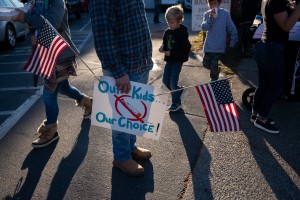
Children walk past a protester with “Our Kids Our Choice” sign during a rally against school vaccine mandates imposed by Gov. Gavin Newsom in front of El Dorado Superior Court on Monday, Oct. 18, 2021, in Placerville.

Gov. Gavin Newsom, right, holds with Sen. Richard Pan, left, a mock-up check for the first 15 Californians to be awarded $50,000 for being vaccinated against COVID-19, while winner and UC Davis assistant nurse manager Claudio Alvarado stands behind, at the California Lottery Headquarters in Sacramento on Friday, June 4, 2021. The randomized drawing is part of California’s new $116.5 million Vax for the Win program – the largest vaccine incentive program in the nation. The program is designed to motivate Californians to get vaccinated leading up to the state’s reopening on June 15.
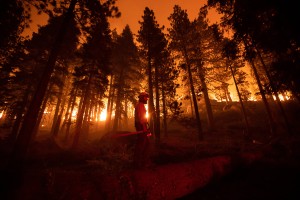
Dustin Johnston of the U.S. Forest Service watches the Caldor Fire advance toward buildings near Meyers on Monday, Aug. 30, 2021. The fire was one of several this season that started on federal land managed by the Forest Service, which has been criticized for its firefighting efforts by elected officials – including Gov. Gavin Newsom.
The photographer took advantage of the light and shadows as the children walked through the frame.
JUDGES
Boyzell Hosey, deputy editor for photography, Tampa Bay Times; Mark Morris, former senior editor/visuals, The Sacramento Bee; and Sue Morrow, editor, News Photographer Magazine
California’s elected officials have enormous influence over the lives of the people they represent. This contest recognizes superb still photography that documents such influence or the impact of decisions and politics throughout the state. Entries may include up to three images that are not breaking news but rather pre-planned journalism that provides emotion, insight, or context.
WINNER
Gabrielle Lurie
San Francisco Chronicle
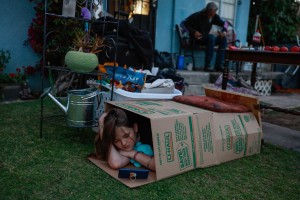
“Grandma, look at my house! I’m gonna make it look pretty”, Bre-Anna Valenzuela,10, exclaimed after building a “house” out of U-Haul boxes in front of her grandmothers house days after being evicted from her home on Thursday, April 8, 2021 in Fresno, California. Despite a moratorium on evictions due to the coronavirus many evictions are still occurring throughout the state. The Valenzuela’s received eviction notices but not under their name and they say they thought it was a mistake. The owner of the house, Louise Traxler, sold it to a real estate company who plans to flip the house.

After being evicted from her home, Fresno Officer T.Miller (right) checks in on Bre-Anna Valenzuela, 10, as her parents fight for her custody outside her grandmother’s home on Sunday, April 11, 2021 in Fresno, California. Since being evicted from their home, the Valenzuela family has been fractured. Bre-Anna’s mother Danetta wants her to move with her to Alabama but she doesn’t want to leave Fresno without her father Brian.
Despite a moratorium on evictions due to the coronavirus many evictions are still occurring throughout the state. The Valenzuela’s received eviction notices but not under their name and they say they thought it was a mistake. The owner of the house, Louise Traxler, sold it to a real estate company who plans to flip the house.
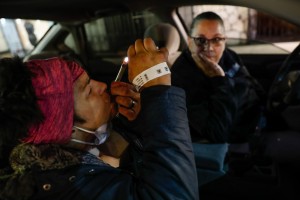
Jessica Didia (left) sits in her mom Laurie Steves’s car as she smokes a mixture of crack and fentanyl together on Wednesday, June 9, 2021 in San Francisco, California. Laurie said she wanted to “smack the pipe out of her hands” but was trying to be welcoming to her daughter in the hopes that by creating a space that was non-judgmental she might be able to reach her better.
This is a wonderful and unique moment to look at the housing eviction crisis in California during the pandemic. The low angle intimately places the viewer in the little girl’s world. The caption was excellent and it was clear the photographer was given the time to make a meaningful and storytelling image.
FINALIST
Andrew Nixon
CapRadio

Alejandra Gonzalez wipes away her daughter’s tears, Valeria Ugalde, 9, after getting a COVID-19 vaccine at the Pannell Center in Sacramento, Friday, Nov. 19, 2021.
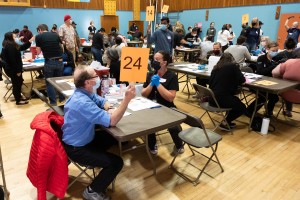
Luther Burbank high school hosts a vaccine clinic in its gym Tuesday, April 13, 2021.

Yer and Rocky Vang prepare corn for sale at their plot in a garden on Lemon Hill Ave on Tuesday, Oct. 5, 2021.
We appreciated this scene for its organized chaos during the pandemic when vaccines were becoming available and uncertainty was palpable. Social distancing is nil in this scene and the body language throughout the room is very storytelling.
JUDGES
Boyzell Hosey, deputy editor for photography, Tampa Bay Times; Mark Morris, former senior editor/visuals, The Sacramento Bee; and Sue Morrow, editor, News Photographer Magazine
Sometimes television or audio can bring out the idiosyncrasies of a public figure that just can’t be conveyed in print. Similarly, broadcast reporters are often challenged in the moment to keep in-person interviews engaging. This category recognizes exceptional interviews that might illuminate or entertain, hold the powerful to account or feature Californians affected by government decisions. Entries are limited to a single story.
WINNER
Scott Shafer and Marisa Lagos
Nancy Pelosi, KQED
- A heightened interview experience.
- Loved the concept of narrating photos. I felt like I was there in the auditorium with them.
- Engaging, clever and insightful. Learned new and surprising backstories.
- Started strong and finished strong. Never let up.
FINALISTS
Jenny Gold
Into the COVID ICU, Kaiser Health News and Reveal (Center for Investigative Reporting and PRX)
- This interview is COVID history.
- Deeply personal and raw. Gorgeously produced.
- This eight-month commitment in reporting one person’s story paid off in perspective and depth.
Elex Michaelson
Jerry Brown, KTTV Fox 11
- Authentic Jerry Brown, who clearly is, as he said, in the best time of his life. The old, familiar “gov” delivers again.
- Enjoyed the natural setting with natural conversation.
- Interviewer found a fresh way to introduce the audience to a known political figure and learn more about Brown’s place in California history.
JUDGES
Catherine Stifter, former senior producer, CapRadio; Kevin Riggs, former news anchor and political reporter, KCRA; Beth Ruyak, owner, Ruyak Media, and former host, “Insight,” CapRadio; and Pamela Wu, director of news and media relations, UC Davis Health, and former news anchor/reporter, KCRA
This category recognizes exceptional reporting about political and policy-driven efforts to combat racial injustice. This could include the politics of policing and its community responses and activism, or efforts by lawmakers to stop systemic racism and injustice. Submissions can be a single story or up to three pieces that demonstrate a command of the subject.
WINNER
Alexandra Yoon-Hendricks and Phillip Reese
“Dangerous by design: How Sacramento’s unwalkable roads imperil and kill Black residents,” The Sacramento Bee
This deep dive by Alexandra Yoon-Hendricks and Phillip Reese into how Blacks suffer disproportionate death and injuries in Sacramento “by design” is a compelling public service. It exposes decades of racial injustice in road planning that prioritizes vehicle traffic and cuts through neighborhoods where people of color live. The multimedia components were also outstanding. Our only lament is that placing the story behind a paywall limits access to readers who may be most affected by this racial injustice.
FINALISTS
Sarah Mizes-Tan
In this collaboration with Reveal and NPR’s California Newsroom, Mizes-Tan delivers an insightful and timely audio story that clearly spells out how a federal aid program failed to reach communities it was designed to help.
Byrhonda Lyons
“In Absentia: No Latino Superior Court judges in these majority-Latino California counties,” CalMatters
This well written story puts a lens on a lesser known consequence of the lack of diversity. As the story notes: “For years, the focus on fairness and equity within the criminal justice system has been on policing, with far less scrutiny to the component of the justice system that wields vast power over attorneys, defendants and how cases are viewed by juries.”
JUDGES
Don Blount, executive editor, Stockton Record; Soraya Sarhaddi Nelson, host, “Common Ground” podcast; and Janine Zacharia, lecturer, Stanford University, and former Jerusalem bureau chief, Washington Post
The path to safely reopen schools in California raised thorny questions about public health, equity and culture. This category recognizes exceptional coverage of those political and policy education issues, from pre-K to K12 and higher education. Submissions can be a single story or up to three pieces that demonstrate a command of the subject.
WINNERS
Paloma Esquivel, Iris Lee, Howard Blume and Melissa Gomez
Los Angeles Times
The LA Times team for data driven reporting that documented just how stark the achievement gap has become among Black and Latino students and their peers during the pandemic, and how principals, teachers are scrambling to close that gap. The challenges uncovered by the reporters, said one of the judges, strikes at the heart of what educators could likely be facing for years to come.
Mackenzie Mays
Politico
Mays exposed a questionable new position in the department Thurmond staffed with a friend, who received a six-figure salary and worked remotely from Philadelphia, “more than 2,500 miles away from the schools he advises.” Few people could detail what achievements the position brought, more than a year after it was formed and it drew criticism from educators in California. Mays’ reporting led to the resignation of Thurmond’s friend. Mays also reported on the toxic inner workings of California Department of Education under Thurmond, talking to supporters and critics about why so many top aides were leaving and how a lack of leadership and experience contributed in part to the confusion and frustration experienced by the state’s school systems during the height of the pandemic.
FINALIST
Guy Marzorati
KQED
Guy Marzorati used data, community voices and solid reporting to highlight a burgeoning political force of parents who wanted their kids to return to the classroom. The judges noted Marzorati’s clear and approachable writing style, “explaining the political and social dilemma parent frustration poses for policy makers.”
JUDGES
Tom Chorneau, novelist and former Capitol reporter, San Francisco Chronicle and the Associated Press; Denice Rios, supervising editor, national desk, National Public Radio; and Jim Sanders, former Capitol reporter, The Sacramento Bee
This category recognizes exceptional reporting on the politics and public policy surrounding business and labor issues including remote work, the very definition of an employee, Big Tech, real estate, and labor law and enforcement. Submissions can be a single story or up to three pieces that demonstrate a command of the beat.
WINNER
Evan Halper, Jackeline Luna and Carolyn Cole
Los Angeles Times
This collection of stories makes complex, technical subjects as engrossing, and as hard to put down, as a mystery novel. The reporting takes us from corporate boardrooms to illegal cannabis farms to the depths of the Pacific Ocean. Exemplary work.
FINALISTS
Brian Edwards and Jacob Margolis
LAist
This story shines light on the heartbreak and daily hardships of those who work in California’s fields, how climate change puts them at greater risk for serious health problems, and what’s NOT being done to protect them. Compelling and important.
Alexander Nieves
Politico
Nieves’ stories on essential worker pay and cannabis policy are even-handed, deeply reported and include myriad perspectives, forcing the reader to reconsider what they thought they knew. The writing puts the reader in the shoes of those affected by government and corporate policy decisions.
JUDGES
Alison ApRoberts, former reporter, The Sacramento Bee; Molly Dugan, professor, Sacramento State; and Jack Sirard, former business editor, The Sacramento Bee
While COVID-19 dominated healthcare headlines in 2021, quality journalism also emerged on other critical topics including mental health and healthcare access. This category recognizes exceptional reporting on a wide range of public health issues, the government response to those issues and politics surrounding them. Submissions can be a single story or up to three pieces that demonstrate a command of the beat.
WINNER
Angela Hart and Bernard J. Wolfson
“Medi-Cal Makeover,” Kaiser Health News
This is terrific public policy reporting that gives Californians clear insights into what is and what is not working in the Medi-Cal program as state leadership prepares for an ambitious, experimental expansion that will impact public health. Judges were impressed by the strength and breadth of reporting across California. Reporters drew upon numerous experts, consumers, data and studies, along with comparisons to new approaches in other states, to examine existing failures of this consequential program. In doing so, they held state leaders to account for basic implementation questions that remain unanswered.
FINALISTS
Jack Dolan, Kim Christensen, Brittny Mejia and Melody Gutierrez
“Botched surgeries and death: How the California Medical Board keeps negligent doctors in business,” Los Angeles Times
This is a deeply reported investigation exposing potential consumer dangers in California’s medical oversight process. Judges liked that the reporting included solid documentation from Medical Board files and court records, along with a database they created from medical licensing records. The series offered help to consumers as well, though a better understanding of how to look into their physician’s record.
Aaron Mendelsohn and Elly Yu
“Immediate Jeopardy: Death And Neglect Inside A Troubled California Nursing Home Chain,” LAist
Judges found this series to be filled with strong investigative reporting, with clear impact, using data, documenting the failures of the regulatory system, and showing those harmed by the failures.
JUDGES
Fenit Nirappil, Washington Post health care and coronavirus reporter; Michelle Raghavan, equity initiative manager, Solutions Journalism Network; and David Tuller, senior fellow in public health and journalism at UC Berkeley’s Center for Global Public Health
Californians felt climate change like never before this year, from wildfires to drought to extreme storms and flooding. This category recognizes exceptional reporting about policy, politics and activism related to water, wildfire, energy, climate change, pollution, endangered species and other environmental topics. Submissions can be a single outstanding story or up to three pieces that demonstrate a command of the beat.
WINNER
Aarón Cantú
Capital and Main
Outstanding investigative reporting focused on the secretive politics of the Kern County oil industry. Drawing on meticulous research, the reporter illuminates both the close relationship between business and government and the consequences for the people living in communities affected by fossil fuel development.
FINALIST
Anna M. Phillips, Tony Barboza, Ruben Vives, Sean Greene, and Genaro Molina
Los Angeles Times
A compelling series on the overlooked (and undercounted) human toll caused by heat waves: well-reported and deftly organized, combining powerful personal anecdotes with groundbreaking data-crunching and policy analysis.
JUDGES
Deborah Blum, Pulitzer Prize winner and director, Knight Science Journalism program, Massachusetts Institute of Technology; Steve Hawk, editor, Stanford Business, and former editor, Sierra; and Ricardo Sandoval-Palos, public editor, PBS
Public polling suggests that housing and homelessness tops the list of issues about which Californians are most concerned. This category recognizes exceptional reporting that explains the causes and effects of the state’s housing crisis and spotlights those it has left behind. Submissions can be a single outstanding story or up to three pieces that demonstrate a command of the beat.
WINNER
Manuela Tobías
CalMatters
Manuela Tobias’ stories on homelessness explore three aspects of the state’s housing crisis: The historically low rates of home ownership among blacks and new local/state strategies to close the gap; the debate over whether demands of building trade unions impede construction of affordable housing on abandoned retail sites; and the fierce resistance to a new law allowing homeowners to build up to four housing units in neighborhoods zoned for single-family homes. For readers frustrated, confused and angered by the inability of political leaders to solve homelessness and affordable housing, Tobias’ reporting helps explain why it is so difficult. It’s a nuanced dive into a topic that often elicits simplistic answers to complicated questions.
FINALISTS
Theresa Clift and Renée C. Byer
The Sacramento Bee
The three submissions by reporter Theresa Clift give readers an intimate portrait of homelessness. Despite numerous efforts and millions of dollars by city and state officials to move people off the streets, this package of stories illustrates the plight of those who remain unhoused. In a city recently cited as having the largest percentage nationwide of homeless families living outdoors, we meet a single mother living with four kids in a subsidized hotel room and a couple with three young children who toggle between hotel rooms and nights in their camper van. Another story takes us to “the island,” a Sacramento River homeless camp comprised of mostly seniors, some of whom have lived there 30 years, but face possible eviction. And finally we meet a homeless couple with two kids and a baby whose RV has been towed, part of countywide efforts to remove hundreds of undriveable vehicles off city streets. These stories don’t bring us any closer to solving California’s homeless/housing problem, but they put a human face on the nagging problem.
JUDGES
Claudia Buck, former reporter, The Sacramento Bee; Andy Furillo, author and former reporter, The Sacramento Bee; and Ginger Rutland, former editor, The Sacramento Bee
The opinion section provides a public forum to hash out the most (and sometimes the least) important issues facing California. This category recognizes exceptional commentary that changed minds, held the powerful to account or perhaps simply delighted its audience. Submissions can be up to three opinion pieces in any format, including editorials, columns, cartoons and videos.
WINNER
Jean Guerrero
Los Angeles Times
Jean Guerrero brought sophistication, solid reporting, precise writing, and sharp opinions to her pieces focused on the recall. Whether you agree with Jean’s takes or not, she made a compelling case in each of the columns she submitted. She made clear the stakes for Latino and Black voters, and showed the connection between the leading challenger to Gavin Newsom, Larry Elder, mentored by one of the leading voices in and most divisive members of the Trump administration, Stephen Miller. Importantly, readers could learn something new from her strong reporting.
FINALIST
Erika D. Smith
Los Angeles Times
The Los Angeles Times’ Erika D. Smith, last year’s winner, is the runner-up. Her strong, well-reported and insightful columns about the recall helped define Larry Elder’s candidacy for much of California.
JUDGES
Ruby Bailey, consumer editor, USA Today; Dan Morain, author and former editorial page editor, The Sacramento Bee; and Rick Rodriguez, professor, Arizona State University, and former executive editor, The Sacramento Bee
This award is for a single story or a series of up to three stories that informed California’s Spanish-speaking community about an influential political or policy issue. The story could be text, audio, video or any combination, and would be judged on news value, depth of reporting and relevance to its audience. Entries will be judged by Spanish-speaking journalists.
WINNER
Eduardo Stanley
Community Alliance
Eduardo Stanley made good use of detail and personal experiences in his description of elderly immigrant workers and brought to life the challenges facing a population that doesn’t get enough attention.
FINALISTS
Kim Bojórquez and Juan Esparza Loera
The Sacramento Bee
- ¿Los votantes Latinos se quedarán con Gavin Newsom?
- ‘No tengo prisa’: Californianos Latinos dudan en tomar la vacuna COVID
- Por que ‘Latinx’ está ganando popularidad, pero entre todo los Latinos
Maricela De La Cruz
KCRA
- EE.UU. levanta restricciones de viaje, Sacramento espera la llegada de más viajeros internacionales
- Co. Sacramento: Casos de COVID-19 siguen en aumento pero las vacunaciones siguen bajas
- Familias Latinas dudan en enviar a hijos a clases presenciales
JUDGES
Jack Chang, former Latin America correspondent, McClatchy and the Associated Press; Maria Jeans, former news producer and reporter, Univision; and Gonzalo Magana, executive producer, special projects and engagement, ABC10 Sacramento
Thank you to our sponsors:









